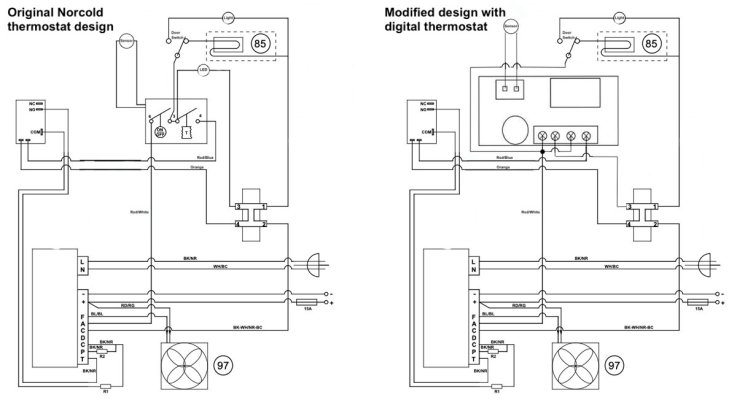HeadedToTexas
Guru
I am replacing the original POS thermostat on my Norcold DE0061 with a new digital model that will maintain a far tighter temperature dead band. The original allows the refrigerator temperature to swing from 33 to 42 degrees. Norcold said that is acceptable. I disagree, hence the new thermostat.
In the process of detailing the wiring, I found a mystery rubber fitting in the top of the insulation layer with a pair of wires disappearing through the fitting. The manual indicates that this is a divider heater. It runs whenever the fridge is on and the door is closed. It's item 85 in the diagram below. A divider heater?
The friendly Norcold Customer Service rep couldn't elaborate much, but the FAQ on Norcold's website indicates that the divider heater "prevent moisture from forming on the center divider between the two doors. This heater operates only when the refrigerator is ON." As in all the time.
I am all for preventing moisture in insulation, but isn't that what insulation is designed to prevent in the first place? How many watts does that divider heater consume? Seems counterproductive to me.
In the process of detailing the wiring, I found a mystery rubber fitting in the top of the insulation layer with a pair of wires disappearing through the fitting. The manual indicates that this is a divider heater. It runs whenever the fridge is on and the door is closed. It's item 85 in the diagram below. A divider heater?
The friendly Norcold Customer Service rep couldn't elaborate much, but the FAQ on Norcold's website indicates that the divider heater "prevent moisture from forming on the center divider between the two doors. This heater operates only when the refrigerator is ON." As in all the time.
I am all for preventing moisture in insulation, but isn't that what insulation is designed to prevent in the first place? How many watts does that divider heater consume? Seems counterproductive to me.

